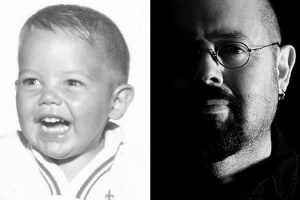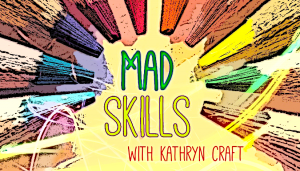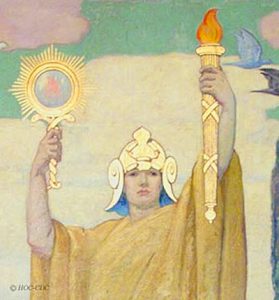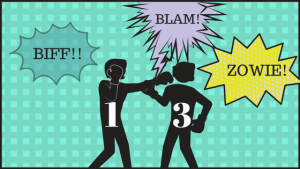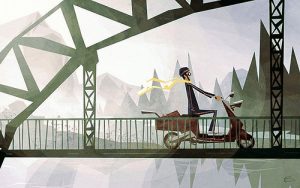Business
Adrian Anghel, Flickr Creative Commons
I recently read a quote on writing I absolutely loved. It’s from Joe Beernink, who said, “Don’t write to become famous or to make a lot of money. Write because you love it. Write because not writing for more than a few days feels like you have abandoned a puppy in a mineshaft. Save the puppy.” The words resonated with me so much, because that’s exactly how I feel. I don’t take days off from writing. Ever. Others may feel boxed-in by strict self-imposed word count goals, but I love them. Having a set word count for the day inspires me, makes me stretch and push past my own equally self-imposed limitations and is my #1 antidote to feeling creative block. I write at least 1,000 words a day, 7 days a week, every single week, every single year, basically no matter what. And to be clear, I’m certainly not suggesting that anyone who doesn’t is less of a writer or less dedicated to their craft. That’s just my own process, what works for me.
I write in good times and bad times. For years, now, I’ve written 1,000 words a day through sickness and new babies and logistical life craziness and tragedy and grief. Even at the lowest, darkest moments, I’ve written because quite simply, however hard life feels in that moment, however hard it is to pick myself up and sit down at the keyboard, not writing would be harder still. And there’s obviously a practical benefit to keeping to a hard and fast writing schedule. Since this time last year, I’ve published 5 books I love and am so happy and grateful to have released into the world.
And yet. There’s always that little, and yet, isn’t there? Because there’s also, in our culture, the very prevalent worship of the “hustle.” We wear busy-ness as a badge of honor, take a certain strange pride in the length of our to-do lists, and convince ourselves that if we just hustle hard enough, we’ll somehow unlock the magical keys to success, riches, rainbows and happiness or whatever our goals might be. Now, of course I believe in the power of hard work and discipline. But the answer isn’t quite as simple as that.
Read MoreFlickr Creative Commons: Theophilos Papadopoulos
Kim here to welcome Dee Willson to Writer Unboxed today! Dee is the award-winning author of A Keeper’s Truth, GOT (Gift of Travel), and No Apology For Being(WIP). You can learn more about Dee on her website, Facebook and Twitter.
So, I find myself blocked by a mountain. Okay, maybe blocked is a strong word. I am facing a mountain. A big, unmovable mountain. This mountain is publishing in a very specific sense. It is the great divide between two major categories created by the publishing world only forty (or so) years ago, but holding strong, despite confusion and change. The divide between YA and ADULT.
Before I go any further, maybe I should be clear: genre and target market are two different things. First Books (FB, Birth-School), Middle Grade (MG, -12), Young Adult (YA, 13-18), Adult (ADULT, 18+)…these are demographics, audiences, ages used by sales, merchandising, and marketing people. Horror, romance, sci-fi, fantasy…these are genres. Stephen King straddles several genres, but mostly writes for an adult audience. Harry Potter, even the last of the series, targets the YA reader, kids under 18. Harry Potter falls under the fantasy genre. Some books blur genre lines, some appeal to more than one audience. I was excited when NEW ADULT hit the scene. But NA got twisted into a genre when it should have been a target market. Two very different things.
Gosh, Dee, get back to the mountain….
Recently, two contradictory things happened in the same moment.
I opened an email from my agent – feedback from the big boys of publishing regarding my latest manuscript. “Love it, but is the author willing to make the protagonist eighteen or under, make the book YA?” My first thoughts were wow, how the hell do I alter an entire manuscript to appeal to a different target market? Can I? Should I? Why? I don’t consider myself a YA author.
While reading this email, I was opening a package, a copy of The Chicago Manual of Style, Seventeenth Edition, ‘The Essential Guide for Writers, Editors, and Publishers’. For those unaware, this is an industry bible. The book mostly covers non-fiction and editorial tips, but what really struck me was that it’s in its seventeenth edition. As in: changed, updated…seventeen times since its original incarnation. I thought, here is this tome, this style manual, rewritten to include up-to-date details, keeping up with the times. It moves, turns like a spoke in some massive publishing wheel.
Would changing my manuscript to YA be a positive change, a nod to society, a give required by the 21st century? Would it tell my character’s story best? Would it sell more books? Would it make me, the author, flexible, a spoke? Or would it be surrender, giving in to a publishing push, intimidated by the mountain?
You might be wondering how I got to this thought process. So let’s take a step back.
I write characters in their early twenties, present day. First person, if it helps to know. It’s a difficult age to write, to voice. So much is happening at this age. And so much is not happening at this age. […]
Read MorePhoto by Diego PH on Unsplash
I have to confess I’ve never been a huge fan of public speaking. And yet, since Everyone Knows You Go Home came out in March, I’ve been on a whirlwind of a book tour that’s consisted of day after day of public speaking.
And I’ve loved every minute of it.
Despite being an introvert and a person who grew up very shy and soft spoken, reading my work in front of audiences has been a transformative experience. Whereas for my first book, I would get nearly unbearably nervous before an event, for my second I’ve learned to embrace the nerves as productive energy. It reminds me a lot of my teens and early twenties, a time when I was a dancer and performed onstage regularly. Always, before curtain, I’d become overwhelmed by a rush of nerves that immediately went away when the music started. There was no going back at that point, so I’d have no choice but to surrender to the moment. Those three to five minutes of dancing were always pure bliss, liberating in ways that are hard to describe.
Reading my work has begun to feel like that as well, but only because I don’t think of it as reading or public speaking. I think of it as a performance. Framed in this way, it’s something I realize I’m lucky to be able to do. Here is an audience—real, live people!—wanting to experience my work.
As a show of gratitude, I try to make that experience as enjoyable as possible. Below are some ways performing affects how I prepare for an event—and how it might help you, too.
Read MoreI’ve been writing professionally – as in, getting paid for my writing – since signing my first contract in 1999. In that time, I’ve written both indie and for traditional publishing houses.
Something I don’t often share: I have also ghostwritten a few books and projects. I don’t publicize it because that’s the nature of the beast. The idea behind ghostwriting is being a ghost, vanishing into the work.
When I talk to writers about ghostwriting, I tend to get two reactions.
The first is a veiled contempt at the concept of not writing one’s own book. They’re not contemptuous of me, necessarily. They just don’t like the whole concept of someone handing off an idea and then taking credit for someone else’s labor. (Of course, not all ghostwriting is like this — there are co-writers, etc. — but this is the thought that often comes up.)
The second reaction is a not-so-veiled eagerness. These are often writers who are eager to quit their soul-sucking day jobs, and who see ghostwriting as a foot in the door, a chance to do what they love (writing) while getting paid. They often ask me how to get ghostwriting jobs.
There are a lot of pros and cons to ghostwriting. It’s like working in food service, in my opinion: it’s a good thing for everyone to try, because you’ll never look at the process the same way again. (You’ll also tip better because you know just how hard the work is. <g>)
If you’re on the fence about pursuing ghostwriting, here are some of my experiences to help you decide.
The Pros
Read More
Deep down, I wanted to label it Climate Fiction, but I wasn’t sure my book fit the criteria. Although I’d read a lot of climate-themed literature, I didn’t quite understand the scope of the genre. Is it even a real genre? Is a microgenre? I had some homework to do.
The term Cli-Fi was coined in 2007 by journalist Dan Bloom. Since then, it has been simmering quietly, but never making enough noise to become its own stand-alone genre in bookstores or on Amazon (although it has garnered buzz in publications such as Scientific American, Chicago Review of Books, The New York Times, and The Guardian.) Like all good books, Climate Fiction novels must tell a compelling story, but beyond the story, they must stir an awareness, an awakening in the reader. Cli-Fi must be based on real science and should further the conversation about our changing environment. It should challenge us to see—or imagine—things differently and reconsider what we accept as normal.
Recently, I’ve seen a flurry of new Cli-Fi novels coming to market, many by debut authors. In the wake of hurricanes Harvey, Irma, and Maria, the on-going US wildfires, and battles over Indigenous water rights, I suspect there are many more in the works.
In my own novel, Four Degrees, everything that happens is a direct result of the four-degree uptick in the temperature in a small New England town. Every plot point directly or indirectly links back to climate. But my book is not about climate change. Plot wise, it is a contemporary story about a 30-year-old murder cover up that resurfaces and derails an entomologist, just as she is about to prove invasive beetles are triggering forest fires during a drought.
I hesitate to label it Climate Fiction (even though I really want to) because I think the moniker conjures up images of apocalyptic stories of rising seas levels and devastating weather events. Most Climate Fiction novels are dystopian or science fiction. My book is neither of those things, and I worry that slapping a Cli-Fi label on it would mislead readers.
Within Climate Fiction, there exists a subset of contemporary, realistic novels. They are not sci-fi, futuristic, or dystopian, but recognizable stories relating climate change as it is already happening.
Maybe this is where my novel belongs.
Barbara Kingsolver’s Fight Behavior is often pointed to as an example of contemporary Climate Fiction. Kingsolver doesn’t get preachy. Her characters are not ecowarriors. She presents a rural Appalachian community with an unexpected event linked to climate change. She allows the characters respond in authentic ways. She doesn’t grab readers by the lapels and shout a climate warning. She doesn’t need to.
Another contemporary example is Ashley Shelby’s South Pole Station about an artist doing a residency in Antarctica. Among the humorous cast of characters is a climate denier. Instead of depicting the climate denier as stupid or uneducated, Shelby treats him with dignity, which makes the story even more compelling. Her treatment of climate deniers as fully rounded characters makes the need to sound the climate alarm even more urgent.
Jesmyn Ward’s Salvage the Bones, which won the 2011 National Book Award, and Robin MacArthur’s 2018 debut Heart Spring Mountain are examples of literary fiction that could also be considered contemporary Climate Fiction. Salvage the […]
Read MoreImage – iStockphoto: Kristina Jovanovic
Hemming in the Tension
When I tweeted up the author Anne R. Allen for writing that “Word count guidelines have been trending down in the last decade,” I found our colleague Hugh Howey checking in from a galaxy far, far away to say, “Slaughterhouse Five, Frankenstein, and Fahrenheit 451 are three of my favorite sci-fi works of all-time, and each is around 50K. The problem part of most novels is the boring middle bit. Best to just leave that part out.”
The desired price of the hardback began to determine the length of the manuscript, which is a weird way to do art. Personally, I'd read more fantasy novels if they came in smaller size but more often. Waiting 7 years for a 1,500 page tome is no bueno.
— Hugh Howey (@hughhowey) March 21, 2018
He’s right, of course, as is Anne Allen, and we went on to discuss (briefly!) the problem some big-name authors run into in this regard, too. I call it the Clancy effect. Once they’re established as a publishing house’s majors, the editorial touch gets lighter, often more pixie dust than anything else. Typos are caught, we have to hope, but developmental work (“structural” edits to your British neighbors) goes out the window.
That can go to anybody’s head, and many of us can name an icon whose work got leggier and sadly shapeless as the big career flabbed on.
I've seen this personally when I edit anthologies. The bigger the name, the more umbrage the author takes with any suggestion. I think writing can get worse over a career because of the unwillingness to be edited (and laziness from the publisher).
— Hugh Howey (@hughhowey) March 21, 2018
Too Much Entertainment
Provocations graphic by Liam Walsh
At London Book Fair last week, another element of this issue came into sharper focus as I moderated a panel for the Byte the Book organization, which looks at the industry from the digital vantage point.
While the session was titled “Publishers Go Prospecting: Finding Hidden Treasure in Your Content,” I’d worked out with our four fine panelists (from the BBC, Penguin Random House, Vodafone, and Hodder Education) an approach that would take us past the obvious issues of spelunking for good backlist titles. (Bring Up the Bodies, as Hilary Mantel might say.)
We looked at today’s mushrooming level of competition for reading time from really fine television and film. After all, you may have felt the first really deep tremor of storytelling’s new cinematic leadership in February when Amazon Publishing created its Topple Books imprint in direct collaboration with Amazon Studios and the activist-filmmaker Jill Soloway (Transparent, I Love Dick, Six Feet Under).
Tom Goodwin
As the futurist and corporate strategist Tom Goodwin told me, “Book publishing is not in the ‘text industry.’ It’s not in the ‘reading industry.’ It’s in the ‘what do people want to spend their time doing? industry.’”
And that’s where the rubber is going to increasingly meet the shortest road possible.
Read MoreA few months ago, in response to a personal conundrum I shared with you, we debated the merits of wrestling a novel that wanted to be written in first-person into third, and whether that would be wise from a marketing perspective. Positions were expounded, personal research advanced, and a few minds possibly changed or stretched. Well, my friends, if you are an indie writer, or traditionally published but able to influence your book’s marketing campaign, the first-third debate doesn’t end there.
You have yet another decision to make.
To wit, have you noticed the accelerating trend toward first-person marketing copy? i.e. taglines or back cover copy written from within the point of view of one or more characters? (Click here for a peek at the current #6 book in the Kindle US store.)
At the time I was putting out Cold and Hottie, given its frequent use by some of contemporary romance’s bestselling authors, I certainly did. But would it be the right move?
To get a handle on best practices, I did an unofficial survey of followers on my Facebook page—presumably people open to my fiction—and asked them what they thought of first-person book blurbs. Before I summarize what they said, I should make it clear that my author page skews heavily toward other writers. Their collective wisdom, therefore, might not extend to readers in general or your genre’s readers in particular. As you might have noticed, a good number of us get hung up on rules that readers don’t see as necessary.
With that said, here are the results:
Read More
Please welcome former WU contributor Jane Friedman back to WU today! Jane has 20 years of experience in the publishing industry, with expertise in business strategy for authors and publishers. She’s the co-founder (with WU’s Porter Anderson) of The Hot Sheet, the essential industry newsletter for authors, and has previously worked for F+W Media (home to Writer’s Digest) and the Virginia Quarterly Review.
Jane’s newest book is The Business of Being a Writer (University of Chicago Press); Publishers Weekly wrote that it is “destined to become a staple reference book for writers and those interested in publishing careers.”
In addition to being a professor with The Great Courses, Jane has delivered keynotes and workshops on the digital era of authorship at worldwide industry events, including the Writer’s Digest annual conference, San Miguel Writers Conference, The Muse & The Marketplace, Frankfurt Book Fair, BookExpo America, LitFlow Berlin, and Digital Book World. Find out more at janefriedman.com.
A Smarter Author Platform for the Digital Era of Publishing
Author platform, in its simplest form, is an author’s ability to sell books. What that platform looks like, or how it works, varies from author to author: Some are big names who can attract attention with any book they release, others have figured out how to harness a local or regional fan base to spread word of mouth, and still others know how to use digital media for visibility.
But by far, digital media—and social media specifically—is the most prevalent and straightforward way that authors are now visible to readers and sell books. In some ways, this has changed publishers’ expectations—and what authors need to do regardless of how they’re published—but in other ways, the game has remained exactly the same. It’s just that now there are more game expansion packs, more players to navigate, and more rules that tend to change in the middle of game play.
Stop Focusing on Social Media Numbers and Look at Your Lead Gen Strategy Instead
When social media was still relatively new, there was a lot of focus and attention on the numbers. How many followers do you have? How many likes? How many shares?
While numbers are still a surface-level indicator of your platform strength, it’s too easy to boost social media activity in an artificial way, leading to numbers that are fairly meaningless. (Even with my own 224,000 followers on Twitter, which is 100% organically grown, a good portion consists of fake accounts that contribute nothing to my platform.) This is why there’s been more attention and focus lately on email newsletters—which indicate more highly engaged readers or followers, not casual or fake ones—and authors collaborating to cater to rather specific audiences or markets, such as Tall Poppy Writers.
A strategic author should evaluate their platform strength on three levels:
Social media can be disappointing when it comes to uncovering new readers if you aren’t spending ad dollars, but it does a great job at engaging people who are already aware of you and your work. Discounts and freebies—regardless of where they’re offered—tend to be better tools for finding new fans. I often hear from authors […]
Read More
